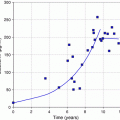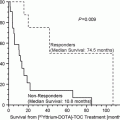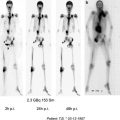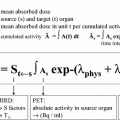Fig. 1
Patient with metastatic ccRC treated over a year with 3 courses of fractionated radioimmunotherapy with 131I-labeled chimeric G250. Anterior and posterior whole body images obtained 2 days after scout (A), and course 1 through 3 (B–D), demonstrating targeting to lung metastasis (arrow)
These studies, taken together, highlight several key elements of radioimmunotherapy of solid tumors in general, and ccRCC in particular (Brouwers et al. 2005a, b). Radioimmunotherapy was well tolerated and generally safe. Kinetics of therapeutic (non-immunogenic) radioimmunotherapy administration could be predicted by a prior infusion, with comparable tumor targeting. External imaging permitted assessment of tumor dosimetry, while serial measurements of blood radioactivity permitted quantification of whole body and marrow radiation absorbed dose. Both studies showed that hematopoietic toxicity was dose-limiting and self-limiting. There was no major treatment response by RECIST criteria following the first treatment course or even in those patients who received multiple treatment courses. There appeared to be a progression-free survival advantage to radioimmunotherapy.
Both studies also demonstrated that changes in serum kinetics could be predictive of an immune response, with a clear relationship between rapid clearance and a HACA response (accompanied usually by lack of tumor targeting). There were however major differences in immunogenicity, allowing for the limitations of trial design. A fractionated schema was much less likely to be immunogenic (2 of 15 patients) than a schema where there was a 3-month or greater interval between treatments (8 of 27 patients). It, thus, appeared that a shorter interval between administrations of xenogeneic protein was more likely to result in tolerance, while longer intervals resulted in an immune response.
4 Future Directions with Radiolabeled cG250 Therapy
131I-cG250 is an ideal radiolabeled antibody for therapy for many reasons. Iodine is the best understood nuclide, having been the backbone of Nuclear Medicine for decades. Any free radioactive iodine can be cleared rapidly by concomitant oral administration of stable iodide and additional thyroid blockade when appropriate. 131I has a relatively “soft” beta-minus emission, limiting radiation dose to contiguous normal tissue. Its gamma emissions, while of relatively high energy, nonetheless permit external imaging and quantification. Attachment of radioiodine to protein is easily accomplished by established direct iodination methods.
Iodinated antibodies however suffer from disadvantages, particularly when the antibody undergoes cellular internalization into lysosomes. This usually results in prompt dehalogenation of the radioiodinated antibody with rapid clearance of the (now unbound) radioactivity. Studies have demonstrated that in internalizing systems, radiometal-labeled antibodies accumulate to a greater extent in tumor than do radioiodinated antibodies (Carrasquillo et al. 1986; Clarke et al. 2000). While there is no convincing evidence that the cG250/CA-IX complex internalizes, the observation, both in patients (Brouwers et al. 2003) and in pre-clinical experiments (Brouwers et al. 2004), that radiometal-labeled cG250 accumulated to a greater extent than did 131I-cG250, spurred the clinical evaluation of radiometal-labeled cG250 for the treatment of metastatic ccRCC.
The Table below lists the nuclides that have been utilized for radioimmunotherapy with cG250. As is immediately evident, all the radionuclides are beta-minus emitters, exerting their cytotoxic effect by low dose-rate radiation.
Nuclide | Half-life | Primary energy | Imaging | Comments |
|---|---|---|---|---|
I-131 | 8 days | β−, 606 keV | Y | Stable iodide blocks uptake. High doses require radiation isolation |
Y-90 | 64 h | β−, 2.27 MeV | N | Out-patient therapy |
Lu-177 | 6.7 days | β−, 498 keV | Y | Low energy gamma. High doses may require radiation isolation |
Yttrium-90 and lutetium-177 are metals and thus need to be conjugated to compounds using chelates. The chelate used for radiometal-labeled cG250 radioimmunotherapy was DOTA (Stillebroer et al. 2012). There are several substantive differences between these two bone-seeking metals however—yttrium-90 has a high beta-minus energy, with consequently high radiation absorbed dose to non-target organs, particularly bone marrow; lutetium-177 has a softer energy and a longer half-life, and its gamma emissions are also lower energy than iodine-131, with consequently less radiation safety concerns. Both radiometals are gaining in utility; an increasing number of macromolecules are now labeled with one or both of these nuclides for therapy.
Phase I studies with radiometal-labeled cG250 are under way. As with prior clinical trials, these were also initiated both at Radboud University and at MSKCC, with escalating amounts of Lutetium-177 cG250 at the former and Yttrium-90 labeled cG250 at the latter. In both trials, the initial imaging study is carried out with Indium-111 labeled cG250. Preliminary results (Stillebroer et al. 2012) have demonstrated that 111In-cG250 imaging can predict radiation dose and hematopoietic toxicity of 177Lu-cG250, and suggest that 177Lu-cG250 may have a better therapeutic window than 90Y-cG250.
Therapeutic options for metastatic ccRCC have changed considerably since the initial explorations with radiolabeled G250 began; this will of course have implications for the future development of radioimmunotherapy with this antibody. Several kinase inhibitors show therapeutic promise (Motzer and Bukowski 2006), and other agents, including mTOR inhibitors, are being approved for use (Cho and Atkins 2011). Moreover, it is becoming clear that solid tumor radioimmunotherapy will be most useful in small volume disease, with an inverse correlation between tumor mass and absorbed dose being observed (Stillebroer et al. 2012). Radioimmunotherapy will therefore be most promising as part of a multi-modality therapy strategy. In this context, the timing of radiolabeled cG250 administration is crucial. This will be determined, of course, based on antigen expression.
Pre-clinical studies have suggested that CA-IX expression begins to decrease soon after initiation of TKi therapy; Oosterwijk-Wakka and her colleagues demonstrated (Oosterwijk-Wakka et al. 2011), in xenograft models, that antibody uptake begins to decrease soon after TKi administration, resuming, especially at the tumor periphery, after discontinuation. It is unclear how these observations translate into effective clinical trial design. Perhaps the radiolabeled antibody should be given first, to maximize tumor uptake, and also perhaps to change what appear to be cytostatic therapies into a tumoricidal combination. The consequent effect however on toxicity is uncertain, since hematopoietic toxicity after radioimmunotherapy is delayed and thus may be additive to TKi myelotoxicity. Nevertheless, it is clear that radioimmunotherapy will need to be one component of a multi-modality therapy strategy, and such pre-clinical studies will need to address these issues to aid in intelligent clinical trial design.
Stay updated, free articles. Join our Telegram channel

Full access? Get Clinical Tree








